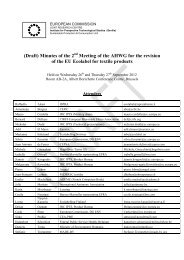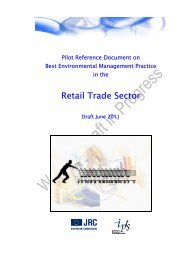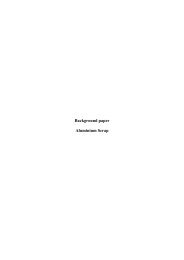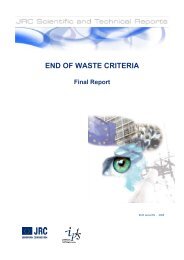final report - JRC IPTS - Sustainable Production and Consumption ...
final report - JRC IPTS - Sustainable Production and Consumption ...
final report - JRC IPTS - Sustainable Production and Consumption ...
You also want an ePaper? Increase the reach of your titles
YUMPU automatically turns print PDFs into web optimized ePapers that Google loves.
EXTENDED SUMMARY<br />
Objectives<br />
The study is intended as an input to the end of waste compost case study in order to obtain background<br />
information about the material flows of the most important types of organic residues <strong>and</strong> wastes which<br />
are used for the production of compost, the various areas of compost application <strong>and</strong> markets <strong>and</strong> the<br />
regulatory frame work in place in EU27.<br />
Task 1: Identify compost classes<br />
Where Member States have established regulations for the production <strong>and</strong> use of compost, the<br />
identification of one or more materials, use or quality related compost types <strong>and</strong> classes can be found.<br />
We have to distinguish between precautionary criteria which are intended to protect the environment<br />
<strong>and</strong> the consumer from any not acceptable negative impact from using the compost <strong>and</strong> those which<br />
relate to certain use aspects in specific application areas. While the first ones are typically found in<br />
statutory frame work legislation the latter ones are rather elements of voluntary st<strong>and</strong>ards <strong>and</strong> market<br />
related quality assurance schemes.<br />
Precautionary compost classes<br />
The most common classification relates to maximum concentration levels of the seven classical heavy<br />
metals (Cd, Cr, Cu, Hg, Ni, Pb <strong>and</strong> Zn).<br />
Where more than one heavy metal related class are laid down they are mostly linked to specific<br />
application areas such as agriculture <strong>and</strong> food production (e.g. class 1) or l<strong>and</strong>scaping <strong>and</strong> l<strong>and</strong><br />
reclamation (e.g. a lower class 2). Further precautionary parameters with limit values are impurities<br />
(physical constraints such as visible particles of metals, plastics <strong>and</strong> glass) <strong>and</strong> pathogenic indicator<br />
organisms such as Salmonella ssp., E. coli, Enterococcae etc.. Both are in principle part of existing<br />
compost st<strong>and</strong>ards <strong>and</strong> regulations.<br />
Organic pollutants are only part of compost criteria where sludge or mixed waste is ruled in as<br />
potential source material (FR [where compost can be produced from mixed waste], DK [where<br />
compost <strong>and</strong> sludge is subject of one unique regulation], AT [for the compost type waste compost<br />
from MSW only]<br />
Identification of the input materials that may be used to produce compost<br />
Another important aspect is the definition of input materials which may be used for the production <strong>and</strong><br />
marketing of compost. Those positive lists may also be classified as precautionary tool in order to<br />
exclude potentially polluted materials from being re-distributed to the environment. As a consequence,<br />
legislation <strong>and</strong> st<strong>and</strong>ards link certain compost designations to the category of input materials used (e.g.<br />
the term quality compost is restricted for compost produced from a specified positive list of ‘clean’<br />
source separated waste materials, whereas compost from mixed municipal solid waste (MWC) must be<br />
named waste compost or stabilised biowaste or similar) <strong>and</strong>/or specified areas of application which are<br />
considered to show different levels of sensitivity (food – non food).<br />
However, input material classification is defined as compost type, where 9 types could be identified:<br />
biowaste compost (source separated collection of organic household waste), green waste compost,<br />
VFG compost (vegetable fruit <strong>and</strong> garden waste without meat), biomix compost (including sewage<br />
sludge), bark compost, manure compost, sludge compost, MSW compost or stabilised biowaste<br />
(produced in MBT plants from mixed residual household waste).<br />
In general we find rather a more or less extensive positive list than a list with material exclusions. The<br />
most prominent waste groups excluded from compost production are<br />
• Municipal Sewage sludge: BE/Fl, DE, FR, LU, NL, SE, UK<br />
• Mixed (not source separated) MSW: BE/Fl<strong>and</strong>ers, DE, FI, LU, NL, UK<br />
12<br />
COMPOST PRODUCTION AND USE IN THE EU










